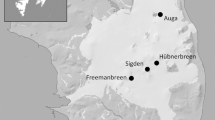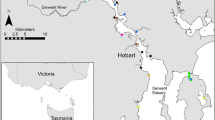Abstract
Residues of polychlorinated biphenyls (PCBs), DDE, DDT, and hexachlorobenzene (HCB) were analyzed for three age classes (e.g., pre-fledge muscle and blood, and post-fledge muscle) of the herring gull, ring-billed gull, and common tern for samples collected in the western end of Lake Superior in 1977. Concentrations of PCBs were highest and HCB concentrations were lowest of the chemicals analyzed in all four sample types and for all three species. Without exception, concentrations of all residues increased from the pre-fledge to the post-fledge stage despite this being a period of dilution. Residue concentrations of PCBs, DDE, and DDT in the eggs were higher (P < .01) for the herring gull than for the ring-billed gull and common tern, but concentrations in the latter two species were similar. All residue concentrations in the pre-fledge samples of the common tern and herring gull were similar (P > 0.05); both species had higher concentrations of PCBs and DDT than the ring-billed gull. The herring gull had higher residue concentrations of HCB and DDE than the ring-billed gull, but the common tern did not differ from the ring-billed gull for HCB or DDE. Residue concentrations among the three species were similar in the post-fledge samples, however, there was an increasing pattern of residue concentrations in the common tern relative to the gull species. Principal component analysis revealed that residue concentrations of PCBs, DDE, and DDT were highly correlated (r > .76) in all three sample types and the first principal component could express a high proportion of the variation (>65%) in residue concentrations. In contrast, HCB residues were more independent and correlated (r > .53) with the second principal component. There was little correspondence between blood residue samples and the pre-fledge muscle samples. Residue concentration differences among the species are probably related to different life histories. The concentrations are below those that affect reproduction in the gull species, but potential impairment cannot be excluded for the common tern.
Similar content being viewed by others
References
Anderson DW, Hickey JJ, Risebrough RW, Hughes DF, Christensen RE (1969) Significance of chlorinated hydrocarbon residues to breeding pelicans and cormorants. Can Field Nat 83:91–112
Arrowhead Regional Development Commission (1984) Colonial bird program St. Louis River Estuary 1984. Report to Minnesota Department of Natural Resources. Duluth, MN
Blus LJ, Gish CD, Belisle AA, Prouty RM (1972a) Logarithmic relationship of DDE residues to eggshell thinning. Nature 235:376–377
— (1972b) Further analysis of the logarithmic relationship of DDE residues to eggshell thinning. Nature 240:164–166
Cooke AS (1973) Shell thinning in avian eggs by environmental pollutants. Environ Pollut 4:85–152
Custer TW, Erwin RM, Stafford C (1983) Organochlorine residues in common tern eggs from nine Atlantic Coast colonies, 1980. Colonial Waterbirds 6:197–204
Cuthbert FJ, McKearnon J, Davis TE (1984) Status of common terns nesting at the Duluth Port Terminal 1982–83. Loon 56:20–24
Davis TE, Niemi GJ (1980) Land breeding populations in the western tip of Lake Superior. Loon 52:3–14
Dieter MP, Perry MC, Mulhern BM (1976) Lead and PCBs in canvasback ducks: relationship between enzyme levels and residues in blood. Arch Environ Contam Toxicol 5:1–13
Fox GA (1976) Eggshell quality: its ecological and physiological significance in a DDE-contaminated common tern population. Wilson Bull 88:459–477
Frank R, Holdrinet MV, Rapley WA (1975) Residue of organochlorine compounds and mercury in birds' eggs from the Niagara Peninsula, Ontario. Arch Environ Contam Toxicol 3:205–218
Gilman AP, Fox GA, Peakall DB, Teeple SM, Carroll TR, Haymes GT (1977) Reproductive parameters and egg contaminant levels of Great Lakes herring gulls. J Wildl Manage 41:458–468
Glass GE, Poldoski JE (1974) Interstitial water components and exchange across the sediment interface of western Lake Superior. Proc XIX Congress, International Assoc Limnol, Winnipeg, Canada
Godfrey WE (1976) The birds of Canada. National Museum of Canada. Bulletin No 203
Goodermote D (1984) A survey of nesting herring gulls along the north shore of Lake Superior from Knife River to the Pigeon River, during the period 1977–1984. Report to Minnesota Department of Natural Resources, St. Paul, MN
Hays H, Risebrough RW (1972) Pollutant concentrations in abnormal young terns from Long Island Sound. Auk 89:19–35
Hickey JJ, Anderson DW (1968) Chlorinated hydrocarbons and eggshell changes in raptorial and fish-eating birds. Science 162:271–273
Keith JA (1966) Reproduction in a population of herring gulls (Larus argentatus) contaminated by DDT. J Appl Ecol 3:57–69
Kress SW, Weinstein EH, Nisbet ICT (1983) The status of tern populations in northeastern United States and adjacent Canada. Colonial Waterbirds 6:84–106
Lemmetyinen R, Rantamaki P, Uusitalo R (1977) DDT and PCB residues in the arctic tern, the osprey, and the hooded crow nesting in the archipelago of southwestern Finland. Lintumies 12:108–117 (in Finnish with English summary)
Lemmetyinen R, Rantamaki P (1980) DDT and PCB residues in the arctic tern (Sterna paradisaea) nesting in the archipelago of southwestern Finland. Ann Zool Fenn 17:141–146
Martin AC, Zim HS, Nelson AL (1951) American wildlife and plants. Dover Publications Inc, New York
Morris RD, Hunter RA, McElman JF (1976) Factors affecting the reproductive success of common tern (Sterna hirundo) colonies on the lower Great Lakes during the summer of 1972. Can J Zool 54:1850–1862
Ohlendorf HM, Klaas EE, Kaiser TE (1979) Environmental pollutants and eggshell thickness: anhingas and wading birds in the eastern United States. Fish and Wildlife Service, Special scientific report. Wildlife No 216, Washington DC
Peakall DB, Lincer JL, Risebrough RW, Pritchard JB, Kinter WB (1973) DDE-induced eggshell thinning: structural and physiological effects in three species. Comp Gen Pharmacol 4:305–313
Ryder JP (1974) Organochlorine and mercury residues in gulls' eggs from western Ontario. Can Field Nat 88:349–352
Särkkä J, Hattula M, Janatuinen J, Paasivirta J, Palokangas R (1978) Chlorinated hydrocarbons and mercury in birds of Lake Paijanne, Finland, 1972–74. Pestic Monit J 12:26–35
Sokal RR, Rohlf FJ (1981) Biometry. WH Freeman, New York
Stickel LF (1973) Pesticide residues in birds and mammals. In Edwards CA (ed) Environmental pollution by pesticides. Plenum Press, New York, pp 254–312
Switzer B, Lewin V, Wolfe FH (1971) Shell thickness, DDE levels in eggs, and reproductive success in common terns (Sterna hirundo) in Alberta. Can J Zool 49:69–73
— (1973) DDE and reproductive success in some Alberta common terns. Can J Zool 51:1081–1086
Tatsuoka, MM (1971) Multivariate analysis: techniques for educational and psychological research. J Wiley Sons Inc, New York
US Environmental Protection Agency (1977) Duluth-Superior, Minnesota and Wisconsin, Report on the degree of pollution of bottom sediments, June 29–30, 1976. United States Environmental Protection Agency, Region V, Great Lakes Surveillance Section, Chicago, Illinois. 17 pp
Veith GD (1975) Baseline concentrations of polychlorinated biphenyls and DDT in Lake Michigan fish, 1971. Pest Monit J 9:21–29
Veith GD, Kuehl DW, Puglisi FA, Glass GE, Eaton JE (1977) Residues of PCBs and DDT in the western Lake Superior ecosystem. Arch Environ Contam Toxicol 5:487–499
Veith GD, Kuehl DW, Leonard EN, Puglisi FA, Lemke AE (1979) Polychlorinated biphenyls and other organic chemical residues in fish from major watersheds of the United States, 1976. Pest Monit J 13:1–11
Vermeer K, Reynolds LM (1970) Organochlorine residues in aquatic birds in the Canadian prairie provinces. Can Field Nat 84:117–130
Author information
Authors and Affiliations
Rights and permissions
About this article
Cite this article
Niemi, G.J., Davis, T.E., Veith, G.D. et al. Organochlorine chemical residues in herring gulls, ring-billed gulls, and common terns of western lake superior. Arch. Environ. Contam. Toxicol. 15, 313–320 (1986). https://doi.org/10.1007/BF01061108
Received:
Revised:
Issue Date:
DOI: https://doi.org/10.1007/BF01061108




